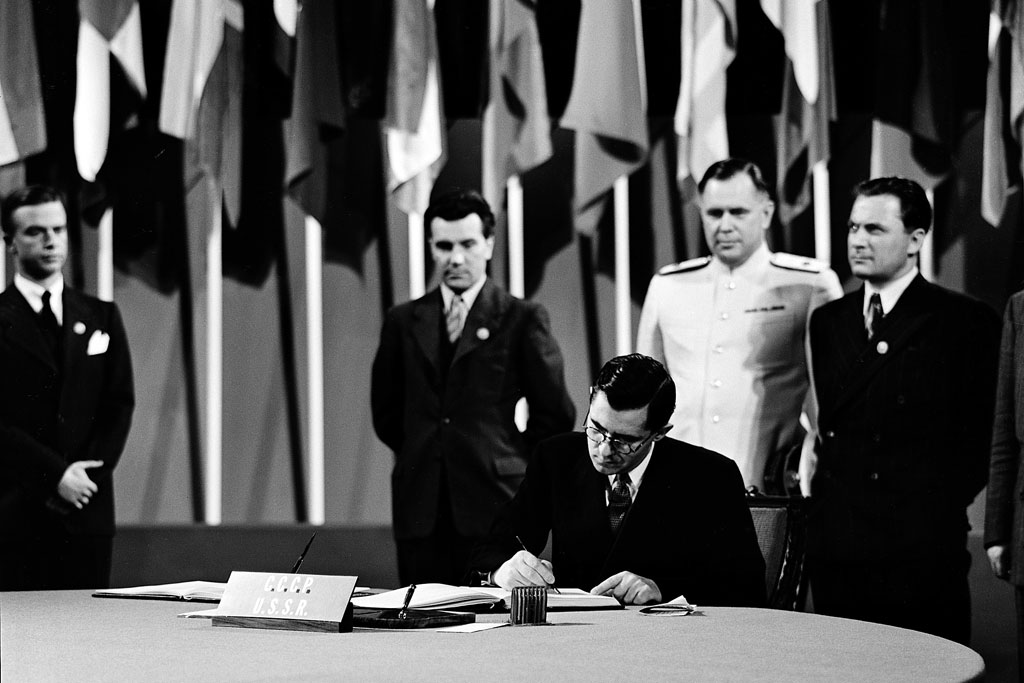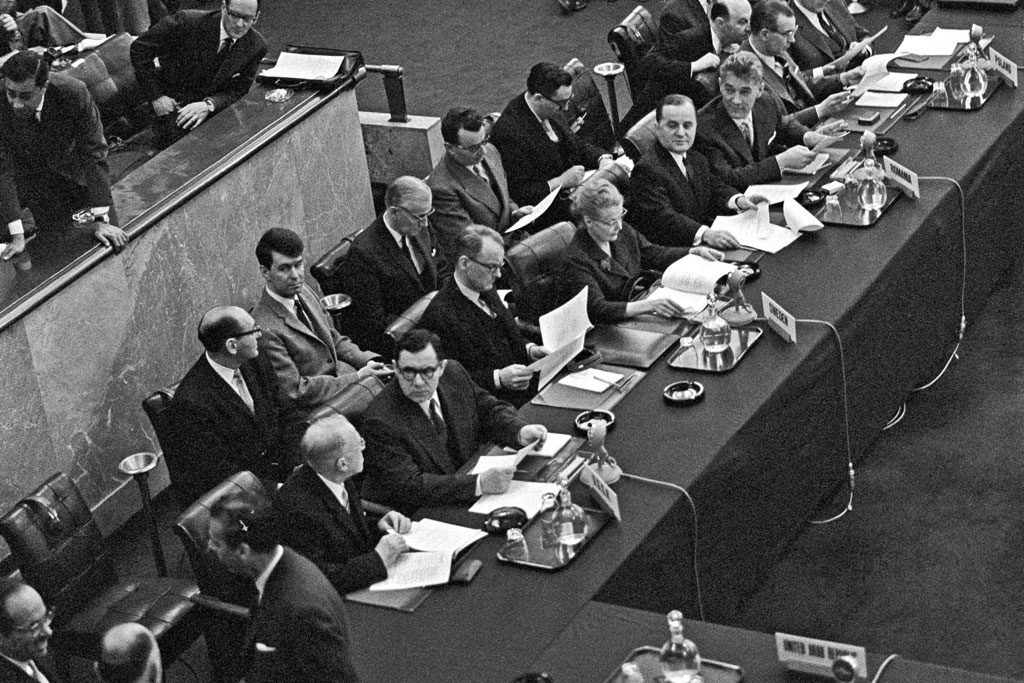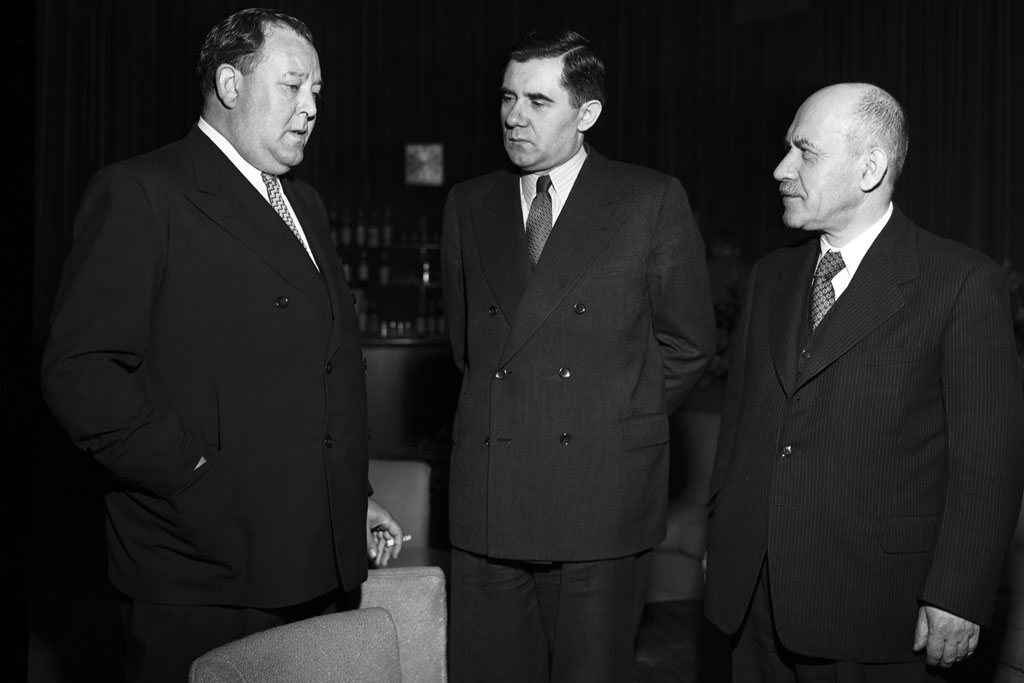Character Sketches: Andrei Gromyko by Brian Urquhart

I first met Andrei Gromyko in London in 1945, where he was representing the Soviet Union on the Preparatory Commission of the United Nations. Gromyko had been a very young wartime Soviet ambassador in Washington and was generally regarded as something of a whiz kid. Most of Gromyko’s colleagues on the Preparatory Commission had worked with him on the drafting of the United Nations Charter. The international climate was now rapidly changing, the smiles and bonhomie of San Francisco giving way to the grim realities that were soon to become the Cold War.
Although some of the spirit of wartime cooperation remained, mutual suspicion and hostility between Stalin’s Soviet Union and the west were growing fast. Gromyko handled his difficult assignment with great skill. The Soviet line had become increasingly unwelcome to the other delegates, though Gromyko himself was still liked and respected. The United States was at that time not only the richest country in the world, but also the only nuclear power. The Soviet Union had been devastated by the war, and while a permanent member of the new UN Security Council, it was physically weak and in a minority. It was Gromyko’s task to reduce the appearance of this inequality as much as possible.
Despite the first ominous symptoms of the Cold War, the proceedings of the UN Preparatory Commission were relatively harmonious and achieved a great deal of organizational work in an extraordinarily short time. Some of the credit for this was certainly due to Gromyko. Dour and gruff in demeanor, his wry humor defused many difficult debates. He liked rather formulaic jokes like saying, after a long debate on a resolution, “I have just one small amendment. It is to add the word ‘not’ in the operative paragraph.” These sallies amused and relieved Gromyko’s colleagues.
One of Gromyko’s most important interventions concerned the permanent location of the headquarters of the future UN. The Europeans and the United States favoured Geneva, from which the Soviet Union had been expelled in 1939 for invading Finland. Gromyko argued that the United States was the best place for the UN’s headquarters. “The United States is located conveniently between Asia and Europe” he said. “The old world had it once and it is time for the new world to have it.” The Soviet Union, remembering that in 1919 the United States had invented the League of Nations and then refused to join it, wanted to make it as difficult as possible for the US to withdraw from the new world organization. Gromyko’s pointof view prevailed, and New York became the UN’s hometown.
Some highlights from the career of Andrei Gromyko, the Soviet Union's top diplomat who served as Permanent Representative to the United Nations before becoming Foreign Minister, a post in which he served from 1957 to 1985 and which had him return to UN Headquarters many times over the decades.
By the time the UN moved to New York City in 1952, the political atmosphere was already much bleaker, and there was notably less diplomatic banter in the daily business at the UN. The debates in the Security Council, which initially met in the converted gymnasium of Hunter College (now Lehman College) in the Bronx, were grim affairs, often involving prolonged verbal battles between East and West. Gromyko, being in a voting minority in the Council, often had to resort to the veto, which led to much outrage in the American press. Lady Theodosia Cadogan, the imperious wife of the British ambassador, was heard, at a public dinner, to ask in high Edwardian tones, “Mr. Gromyko, why don’t you stop that stupid veto?”!!
Gromyko created a sensation by walking out of the Security Council in protest at the debate on the presence of Soviet groups in Iran in 1946. His absence set a precedent which had unintended and far-reaching consequences. At the start of the Korean crisis in 1950, the Soviet Union was boycotting the Security Council in protest against Taiwan’s representing China in the UN and was therefore unable to veto the decision to launch a UN force to counter the North Korean invasion of South Korea. After that mistake no Soviet ambassador was allowed to leave his seat at the table while the Security Council was in session, even to go to the bathroom.
Gromyko remained the dominant spokesman for Soviet foreign policy until shortly before his death. This must have required enormous discipline and self-restraint. Unlike other Soviet cold warriors – Yakov Malik, Andrei Vishinsky, Valerian Zorin – Gromyko, however adversarial, was always dignified and never descended to the gutter level of abuse and name-calling often reached by the others. Soviet leaders, taking Gromyko for granted, delighted in attempting to humiliate him. The buffoon Khrushchev told a visiting foreign dignitary, “That is Gromyko, my foreign minister. If I tell him to pull down his pants and sit on a block of ice, he will do it.”
I had my last direct contact with Gromyko in 1973. We were in Geneva for the Middle East Peace Conference after the 1973 Yom Kippur war. Secretary General Kurt Waldheim had been charged with organizing this highly publicized meeting and, as so often in such affairs, the seating arrangements presented major symbolic difficulties. We had finally come up with a plan in which the Unites States and the USSR, as the co-chairmen of the conference, would be seated as buffers between the most mutually hostile members. This meant, among other things, that the USSR would be seated next to Israel. Henry Kissinger agreed to persuade Israel to accept this arrangement if Waldheim could get Gromyko to accept it. I was dispatched on this errand and found Gromyko in his fun-loving mood. This, he said, was a challenge he had been awaiting for twenty years. When I said that time was very short and urged him to accept, he replied, “On one condition. Henry Kissinger must ask me on his knees.” I brought Kissinger over, and after much badinage Gromyko finally accepted graciously. The conference opened only forty minutes late.

26 June 1945 – Andrei Gromyko’s involvement in foreign affairs began early. He joined the diplomatic service of the Union of Soviet Socialist Republics (USSR) at the age of 30 in 1939. He was appointed the Soviet Union’s Permanent Representative to the United States in 1943, and took part in many of the international gatherings which led to the creation of the United Nations. Here, he signs the UN Charter at the UN Conference on International Organization (also known as the San Francisco Conference given its location), which reviewed previous steps to forming the world body and the creation of the UN Charter. UN Photo

26 June 1945 – The San Francisco Conference was a key moment in the creation of the United Nations, bringing together thousands of delegates, representatives, journalists and observers at what is considered one of the largest international gathering ever to take place. Here, the Chairman of the US delegation, Edward R. Stettinius, Jr., presents the gathering's gavel to Ambassador Gromyko at the last public session of the Conference. The following year would see Amb. Gromyko leave his post as the USSR’s representative to the US to take up the post of the Soviet Union’s first Ambassador the UN. UN Photo

25 March 1946 – Amb. Gromyko served as the USSR’s Permanent Representative the UN for two years. Here, he is shown leaving after the UN Security Council’s first session, held at Hunter College in New York state, before the world body had its permanent headquarters in New York City. While serving in the ambassadorship, he also held the position of Deputy Minister of Foreign Affairs for the USSR. UN Photo

25 May 1946 – UN Secretary-General Trygve Lie held a party at the Waldorf Astoria Hotel in New York City to honour delegates to the world body’s newly-formed Security and Economic and Social Councils. Here, the Secretary-General's wife, Hjordis Joergensen, welcomes Amb. Gromyko to the event. UN Photo

7 May 1947 – Amb. Gromyko was heavily involved in matters being debated at the United Nations. Here, he is shown conferring with the representatives from Venezuela and Uruguay before the opening of the First Special Session of the General Assembly, at the UN’s temporary location in Lake Success, in New York state. UN Photo

25 September 1947 – Then as now, there was a range of pressing issues on the agenda of the international community. Here, Secretary-General Lie confers with Amb. Gromyko before the 60th meeting of General Assembly's First Committee, which deals with matters related to security. In this instance, the 55-nation Committee agreed by 38 votes to six, with five abstentions, to ask the representatives of Albania and Bulgaria whether they were prepared to accept and apply the provisions of the Charter in the settlement of the so-called Greek question. At the time, Greece was going through a civil war. UN Photo

24 February 1948 – Another major topic for consideration before the international community was that of Palestine. Here, Amb. Gromyko (second from left at main table) and other Security Council members listen to the UK Secretary of State for the Colonies, Arthur Creech-Jones, address the matter. UN Photo

7 October 1958 – In 1948, Amb. Gromyko left his post of the USSR’s representative to the UN. He held various senior diplomatic posts, including First Deputy Minister of Foreign Affairs and Ambassador to Great Britain, before being appointed the USSR’s Minister of Foreign Affairs in 1957. He remained in that post until 1985. Shown here, Foreign Minister Gromyko is at a press conference during the opening weeks of the 13th session of the UN General Assembly. Mr. Gromyko headed his country's delegation to the session. UN Photo

29 September 1960 – As the USSR’s Foreign Minister, Gromyko was present for many General Assemblies over the years. Shown here, he watches on during the Assembly’s 15th session as the Chairman of the Council of Ministers of the USSR, Nikita Khrushchev, rises to his feet during the address of UK Prime Minister Harold Macmillan. UN Photo/Yutaka Nagata

14 March 1962 – Being at the helm of the USSR’s foreign ministry saw Gromyko attend various international events around the globe. Shown here (second from left), he is at the opening of a UN disarmament conference in the Swiss city of Geneva. UN Photo

4 August 1963 – In his role as the Soviet Union’s top diplomat, Gromyko was present for the signing of the Nuclear Test-Ban Treaty in Moscow by representatives of the USSR, the UK and the US on 5 August 1963. The day before, he accompanied the USSR’s premier, Nikita Kruschev, in meeting with UN Secretary-General U Thant who had arrived to attend the signing. UN Photo

16 October 1963 – At the invitation of UN Secretary-General U Thant, Soviet cosmonauts Yuri Gagarin (wearing military cap and facing the camera) and Valentina Tereshkova, the first man and the first woman in outer space, visited UN Headquarters. Shown here, journalists and photographers surge around the cosmonauts, who are accompanied by Foreign Minister Gromyko, as they arrive at the UN premises. UN photo

3 October 1968 – At the high-level segment at the opening of each General Assembly, international leaders and representatives share their views on current international issues. Here, Foreign Minister Gromyko addresses the Assembly. Those seated behind him include Secretary-General U Thant (seat left) and General Assembly President Emilio Arenales of Guatemala. The Assembly is the main deliberative, policymaking and representative organ of the UN. UN Photo

1 September 1982 – With close to 30 years as the USSR’s top diplomat, Foreign Minister Gromyko dealt with many UN Secretaries-General. Here, he is shown accompanying Leonid I. Brezhnev (centre), General Secretary of the Central Committee of the Communist Party of the USSR and President of the Supreme Soviet, during a meeting with Secretary-General Javier Perez de Cuellar (left) in Moscow. UN Photo
In meeting with style and dignity the formidable challenge of representing the Soviet Union to a largely hostile world, Gromyko became an international institution. Despite the bitter political climate, those who dealt with him from the other side of the East-West divide never lost their respect, even affection for him.


